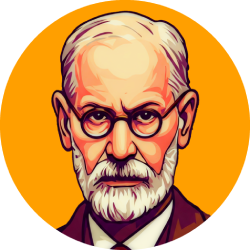WP: Heading
INTRODUCTION: The real road to the unconscious
/WP: Heading
WP: Paragraph
When Sigmund Freud published “The Interpretation of Dreams” in 1900, he not only presented a new psychological theory – inaugurated a revolution in understanding the human mind. This monumental work has established dreams asthe royal road that leads to the unconscious, a powerful metaphor that remains relevant more than a century later.
/WP: Paragraph
WP: Paragraph
But what doesdreamssuch a crucial element in Freudian theory? Why did Freud pay such attention to these nightly experiences that we all experience? And how did your approach revolutionize our understanding of the human mind?
/WP: Paragraph
WP: Heading
What are dreams for Freud?
/WP: Heading
WP: Paragraph
ToFreud, youdreamsThey are not mere random products of a sleeping mind. They representrepressed desiresthat remain latent in the unconscious. When we sleep, the mechanisms of censorship of the mind relax, allowing content normally inaccessible to consciousness to emyrve, albeit in a distorted manner.
/WP: Paragraph
WP: Paragraph
The great discovery ofFreud about dreamsIt was realized that while they may seem illogical or absurd at first glance, dreams follow their own logic – the logic of the unconscious. The dream symbols are not arbitrary, but coded representations of our deepest conflicts and desires.
/WP: Paragraph
WP: Paragraph
In Freud’s own words: “The dream is the fulfillment (disguised) of a (repressed) desire.” This concise formulation captures the essence ofFreudian dream interpretation.
/WP: Paragraph
WP: Heading
The work of the dream: how our unconscious communicates
/WP: Heading
WP: Paragraph
One of the most original contributions ofDream interpretationofFreudIt was the identification of the process called “dream work” – the mechanism by which the unconscious transforms repressed desires into dream content. This process occurs through four main mechanisms:
/WP: Paragraph
WP: Heading {“Level”: 3}
1. Condensation
/WP: Heading
WP: Paragraph
In condensation, multiple elements, people or situations are combined in a single dream image. It is as if the unconscious created a “compacted file” of meanings:
/WP: Paragraph
WP: List
- WP: List-Itam
- A person in the dream can represent several people from real life
- A single symbol can condense several meanings
- Several experiences can merge into a single scene
/WP: List-Itam
WP: List-Itam
/WP: List-Itam
WP: List-Itam
/WP: List-Itam
/WP: List
WP: Paragraph
Condensation explains whydreamsThey often seem so dense and meaningful – they are effectively.
/WP: Paragraph
WP: Heading {“Level”: 3}
2.
/WP: Heading
WP: Paragraph
Displacement is a protection mechanism par excellence. Here, the emotional intensity of unacceptable thinking is transferred to another seemingly harmless element:
/WP: Paragraph
WP: List
- WP: List-Itam
- A conflict with the authority figure can appear as a confrontation with a strange
- A repressed sexual desire can manifest itself as an object or activity apparently without relation
- Strong anxiety can move to a secondary element of the dream
/WP: List-Itam
WP: List-Itam
/WP: List-Itam
WP: List-Itam
/WP: List-Itam
/WP: List
WP: Paragraph
This mechanism explains why, inFreud Dream InterpretationIt emphasizes that often the most insignificant elements of the dream can be the most revealing.
/WP: Paragraph
WP: Heading {“Level”: 3}
3. Figure (representability)
/WP: Heading
WP: Paragraph
Figure turns abstract thoughts into concrete images, allowing complex ideas to be visually represented:
/WP: Paragraph
WP: List
- WP: List-Itam
- Feeling overloaded can appear as being carrying a physical weight
- Feelings of guilt can manifest as dirty or stained
- Abstract ideas like love, death or time gain symbolic representations
/WP: List-Itam
WP: List-Itam
/WP: List-Itam
WP: List-Itam
/WP: List-Itam
/WP: List
WP: Paragraph
This aspect of dream work reveals the extraordinary creativity of the unconscious by translating emotions and thoughts into visual language.
/WP: Paragraph
WP: Heading {“Level”: 3}
4. Secondary elaboration (play)
/WP: Heading
WP: Paragraph
Finally, secondary elaboration organizes the previous elements in a semi -structured narrative, trying to give some coherence to dream material:
/WP: Paragraph
WP: List
- WP: List-Itam
- Creates a temporal sequence between disconnected elements
- Fills logical gaps to create a seemingly cohesive story
- Tries to give an “acceptable” look to the content of the dream
/WP: List-Itam
WP: List-Itam
/WP: List-Itam
WP: List-Itam
/WP: List-Itam
/WP: List
WP: Paragraph
This last mechanism explains why we can retell ourdreamsAs stories, even when, deeply analyzed, they lack conventional logic.
/WP: Paragraph
WP: Heading
Manifest content and latent content: both levels of dreams
/WP: Heading
WP: Paragraph
A fundamental distinction inDream interpretationofFreudIt is the difference between manifest content and latent content:
/WP: Paragraph
WP: List
- WP: List-Itam
- Manifest content: It is the dream as we remember – the images, sounds and sensations that we experience directly
- Latent content: It is the hidden meaning of the dream – the unconscious desires and conflicts that motivated the dream
/WP: List-Itam
WP: List-Itam
/WP: List-Itam
/WP: List
WP: Paragraph
The difference between these two levels is precisely the result of the work of the dream. Manifest content is like an elaborate disguise that protects the sleeping ego from the disturbing impact of the latent content.
/WP: Paragraph
WP: Paragraph
ToFreud, aDream interpretationIt consists of reversing this process – unraveling the mechanisms of distortion to reveal the repressed desire that is the origin of the dream.
/WP: Paragraph
WP: Heading
The technique of interpretation: how to access the meaning of dreams
/WP: Heading
WP: Paragraph
How then we can discover themeaninghidden from ourdreams?Freuddeveloped a revolutionary technique based on free association:
/WP: Paragraph
WP: List {“Ordered”: True}
- WP: List-Itam
- Detailed Dream Report: The first step is to remember and report the dream with as much detail as possible
- Free association: For each element of the dream, the dreamer shares the first ideas, memories or feelings that come to mind
- Analysis of symbols: Some recurrent dream symbols may have culturally shared meanings
- Contextualization: The dream is interpreted in the context of the current life and the personal history of the dreamer
- Integration: The meanings revealed are integrated with the broader understanding of the individual’s psychic standards
/WP: List-Itam
WP: List-Itam
/WP: List-Itam
WP: List-Itam
/WP: List-Itam
WP: List-Itam
/WP: List-Itam
WP: List-Itam
/WP: List-Itam
/WP: List
WP: Paragraph
It is crucial to understand that, forFreud about dreams, there is no “universal” symbol dictionary. Although certain symbols may have widely shared meanings (such as parental figures or elements of nature),Dream interpretationIt must always be personalized.
/WP: Paragraph
WP: Heading
Differences between the approaches of Freud and Jung
/WP: Heading
WP: Paragraph
Understanding ofdreamsevolved considerably in the history of deep psychology. The divergence betweenFreud and the dreamsversus Carl Jung’s approach represents one of the most significant debates:
/WP: Paragraph
WP: Heading {“Level”: 3}
Freudian approach
/WP: Heading
WP: List
- WP: List-Itam
- Focus: Repressed desires, especially of a sexual nature
- Origin: Personal content repressed in the individual unconscious
- Function: Achievement disguised as desires
- Method: FREE ASSOCIATION To decipher the latent content
/WP: List-Itam
WP: List-Itam
/WP: List-Itam
WP: List-Itam
/WP: List-Itam
WP: List-Itam
/WP: List-Itam
/WP: List
WP: Heading {“Level”: 3}
Jungian approach
/WP: Heading
WP: List
- WP: List-Itam
- Focus: Processes of individuation and self -knowledge
- Origin: Both the personal and the collective (archetypes) unconscious
- Function: Compensation, integration and guidance of psychic development
- Method: Symbolic amplification, cultural and mythological context
/WP: List-Itam
WP: List-Itam
/WP: List-Itam
WP: List-Itam
/WP: List-Itam
WP: List-Itam
/WP: List-Itam
/WP: List
WP: Paragraph
Jung expanded the vision ofdreamsBeyond repressed desires, seeing them as messages from the self (the organizing center of the psyche) that seek to balance consciousness. For Jung, thedreamsThey have a prospective function – not only revealing the past, but also indicating potential paths of development.
/WP: Paragraph
WP: Heading
The contemporary relevance of the interpretation of dreams
/WP: Heading
WP: Paragraph
Modern science has explored thedreamsThrough neurobiology, cognitive psychology and sleep laboratory studies. Although these approaches revealed a lot about the brain mechanisms of dreams, theDream interpretationFreudiana maintains a unique relevance:
/WP: Paragraph
WP: List {“Ordered”: True}
- WP: List-Itam
- Clinical value: Dream analysis remains a valuable therapeutic tool
- Unconscious communication: Dreams still represent a privileged way to access unconscious content
- Self -awareness: Reflection on the dreams themselves promotes psychic integration
- Emotional processing: Dreams help in the elaboration of difficult or traumatic experiences
/WP: List-Itam
WP: List-Itam
/WP: List-Itam
WP: List-Itam
/WP: List-Itam
WP: List-Itam
/WP: List-Itam
/WP: List
WP: Paragraph
The discoveries of neuroscience on emotional processing during sleep and memory consolidation offer new angles to understand whatFreudintuited through clinical observation: thedreamsplay a crucial role in psychic functioning.
/WP: Paragraph
WP: Heading
Possible variations in the interpretation of dreams
/WP: Heading
WP: Paragraph
THEDream interpretationIt is not a monolithic field. Different contemporary approaches offer complementary perspectives:
/WP: Paragraph
WP: Heading {“Level”: 3}
Existential approach
/WP: Heading
WP: Paragraph
See thedreamsas expressions of the dreamer’s existential situation and its fundamental choices. The focus is less in the past and more in the present and its future possibilities.
/WP: Paragraph
WP: Heading {“Level”: 3}
Cognitive behavioral approach
/WP: Heading
WP: Paragraph
Interprets thedreamsas reflexes of thought patterns and conscious concerns. YoudreamsThey are seen as continuation of daytime cognitive processing.
/WP: Paragraph
WP: Heading {“Level”: 3}
Narrative approach
/WP: Heading
WP: Paragraph
Understand thedreamsAs significant personal stories that express the dreamer’s identity and values, offering new angles to reinterpret their own life.
/WP: Paragraph
WP: Heading {“Level”: 3}
Transpersonal approach
/WP: Heading
WP: Paragraph
Expands Jungian vision, seeing thedreamsas possible transpersonal experiences that transcend the conventional limits of the ego and can connect the dreamer to the broader dimensions of existence.
/WP: Paragraph
WP: Heading
Conclusion: The interpretation of dreams as a path to self -knowledge
/WP: Heading
WP: Paragraph
More than a century after its publication, Sigmund Freud’s “Dream’s Interpretation of Dreams” remains a revolutionary work. In establishing thedreamsas significant manifestations of the unconscious,Freudhas paved a new way to human self -knowledge.
/WP: Paragraph
WP: Paragraph
THEDream interpretationIt invites us to a constant dialogue with our own unconscious – a dialogue that can reveal unknown aspects of ourselves, integrate fragments dissociated from our experience and enrich our conscious life.
/WP: Paragraph
WP: Paragraph
Whether in clinical practice, academic research or personal reflection,dreamscontinue to fascinate and instruct. They remind us that the human psyche is wider and more complex than our daytime consciousness can grasp – and that, in the poetic expression ofFreud, youdreamsThey are truly the “real road” to discover this inner vastness.
/WP: Paragraph


